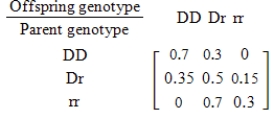For species that reproduce sexually, characteristics are determined by a gene from each parent. Suppose that for a certain trait there are two possible genes available from each parent: a dominant gene D and a recessive gene r. Then the different gene combinations (called genotypes) for the offspring are DD, Dr, rD, and rr, where Dr and rD produce the same trait. Suppose further that these genotypes are the states of a Markov chain with the transition matrix given below. If the initial occurrence of those genotypes in the population is 0.1 for DD, 0.2 for Dr, and 0.7 for rr, find the distribution (probability) of each type of the second generation of offspring. Round all numerical values in your answer to two decimal places. 
A) 
B) 
C) 
D) 
E) 
Correct Answer:
Verified
Q168: Find the steady-state vector associated with the
Q169: The local community-service funding organization in a
Q170: A Markov chain has transition matrix
Q171: Suppose a government study estimated that the
Q172: A man owns an Audi, a Ford,
Unlock this Answer For Free Now!
View this answer and more for free by performing one of the following actions

Scan the QR code to install the App and get 2 free unlocks

Unlock quizzes for free by uploading documents